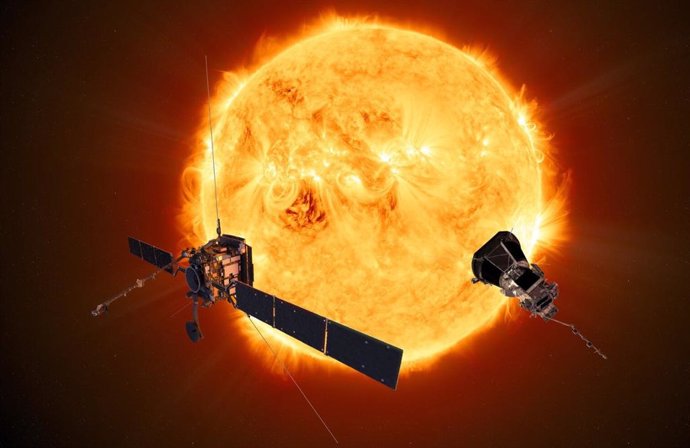Illustration of the Solar Orbiter and Solar Parker probes – THAT
Aug. 30 () –
ESA’s Solar Orbiter spacecraft has provided crucial data to answer the decades-old mystery of where the energy that heats and accelerates the solar wind comes from.
Working in conjunction with NASA’s Parker Solar Probe, Solar Orbiter reveals that the energy needed to help power this flow comes from large fluctuations in the Sun’s magnetic field.
The solar wind is a constant stream of charged particles escaping from the solar atmosphere (called the corona). to flow beyond the Earth. It is the collision of the solar wind with our planet’s atmosphere that triggers the colorful aurora in our skies.
The “fast” solar wind moves at speeds in excess of 500 km/s, equivalent to a whopping 1.8 million km/h. Interestingly, this wind exits the Sun’s corona at lower speeds, so it is somewhat accelerated as it moves away. The million-degree wind naturally cools as it expands into a larger volume and becomes less dense, much like the air on Earth when you climb a mountain. And yet it cools more slowly than expected due to this effect alone.
ALFVÉN WAVES
So what provides the energy needed to speed up and heat the fastest parts of the solar wind? Data from ESA’s Solar Orbiter and NASA’s Parker Solar Probe have provided conclusive evidence that the answer is large-scale oscillations in the Sun’s magnetic field, known as Alfvén waves.
“Before this work, it had been suggested that Alfvén waves were a source of potential energy, but we had no definitive evidence,” he says. in a statement co-lead author of the paper Yeimy Rivera of the Harvard-Smithsonian Center for Astrophysics in Massachusetts.
In an ordinary gas, such as the Earth’s atmosphere, the only type of waves that can be transmitted are sound waves. However, when a gas is heated to extraordinary temperatures, such as in the Sun’s atmosphere, it enters an electrified state known as plasma and responds to magnetic fields. This allows waves, called Alfvén waves, to form in the magnetic field. These waves store energy and can transport it efficiently through a plasma.
A normal gas expresses its stored energy in the form of density, temperature and velocity. However, in the case of plasma, the magnetic field also stores energy. Both Solar Orbiter and Parker Solar Probe contain the instruments needed to measure the properties of plasma, including its magnetic field.
Although the two spacecraft operate at different distances from the Sun and in very different orbits, in February 2022, The spacecraft aligned itself along the same solar wind stream.
Parker, operating 13.3 solar radii (about 9 million kilometers) from the Sun, at the outermost edges of the solar corona, crossed the stream first. Solar Orbiter, operating at 128 solar radii (89 million kilometers), crossed the stream a day or two later. “This work was only possible thanks to the very special alignment of the two spacecraft that sampled the same solar wind stream at different stages of its journey from the Sun,” Yeimy says.
Making the most of this rare lineup, the team compared measurements of the same plasma stream at two different locationsThey first transformed the measurements into four key energy quantities, including a measurement of the energy stored in the magnetic field, called the wave energy flux.
Since energy is neither created nor destroyed, only converted from one form to another, the team compared Parker’s readings to those from Solar Orbiter. They made this comparison with and without the magnetic energy term.
“We found that if we don’t include the wave energy flux at Parker, we don’t exactly match the amount of energy we have at Solar Orbiter,” says joint first author Samuel Badman of the Harvard-Smithsonian Center for Astrophysics in Massachusetts.
Near the Sun, where Parker measured the current, about 10% of the total energy was found in the magnetic field. At Solar Orbiter, this number had dropped to just 1%, but the plasma had sped up and cooled more slowly than expected.
Comparing the numbers, the team concluded that the lost magnetic energy was driving the acceleration and slowing the cooling of the plasma by providing some heating of its own.
The data also show the importance of magnetic configurations known as zigzags for wind accelerationZigzags are large deviations in the Sun’s magnetic field lines and are examples of Alfvén waves. They have been observed since the first solar probes in the 1970s, but their detection rate has increased dramatically since Parker Solar Probe became the first spacecraft to fly through the Sun’s corona in 2021 and detected the zigzags coalescing into patches.
This new work confirms that these zigzag patches contain enough energy to account for the missing portion of the acceleration and heating of the fast solar wind.





![[Img #74664]](https://thelatestnews.world/wp-content/uploads/2024/12/James-Watson-The-controversial-genius-behind-the-double-helix-150x150.jpg)







![[Img #74664]](https://thelatestnews.world/wp-content/uploads/2024/12/James-Watson-The-controversial-genius-behind-the-double-helix-300x200.jpg)


Add Comment